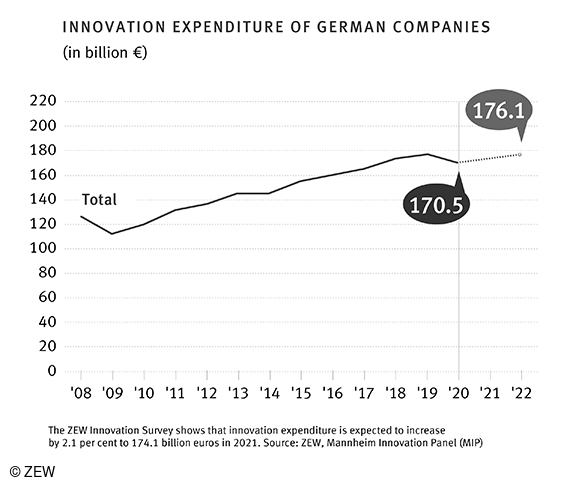COVID-19 Pandemic Is Both an Obstacle and an Impetus for Innovation
ResearchInnovation Survey 2021
German companies reduced their innovation spending by 3.6 per cent to 170.5 billion euros in the first year of the COVID-19 crisis. Twelve per cent of companies did not undertake any innovation activities at all due to the pandemic. At the same time, eleven per cent of the companies invested in additional product innovations in response to the pandemic situation and twelve per cent pushed ahead with additional process innovations. These are key findings of the Innovation Survey 2021, which ZEW Mannheim conducted among German companies on behalf of the German Federal Ministry of Education and Research.
Federal Research Minister Bettina Stark-Watzinger explains: “Germany is still a country of innovation. The ZEW Mannheim survey shows that our economy has remained innovative even during the COVID-19 crisis. Although corporate innovation spending declined in the first year of the pandemic for the first time in more than ten years, there are signs of a trend reversal. I am worried about the small and medium-sized enterprises that want to spend less on innovation. They need support so that they don’t run out of breath. We want to usher in a decade of innovation. For this, it is crucial to make great leaps and achieve breakthroughs. In addition, the findings from research must also find their way into companies. That is why we will give more autonomy to the German Agency for Breakthrough Innovations (SPRIND), establish the German Agency for Transfer and Innovation (DATI) and promote spin-offs. We can no longer afford to let this potential go unused.”
“In terms of innovation, companies in Germany experienced many obstacles as a result of the pandemic. Many companies were not able to implement their innovation projects as planned, they were postponed or delayed,” explains Professor Achim Wambach, president of ZEW Mannheim. “Investment spending on new or improved machinery and equipment decreased particularly sharply, by as much as ten per cent.” The drop in innovation spending primarily affected large companies. However, the target figures for 2021 and 2022 show that the decline should soon be offset. In 2021, innovation spending is expected to increase by 2.1 per cent to 174.1 billion euros. In the current year 2022, expenditure could rise by a further 1.2 per cent to 176.1 billion euros.
Small and medium-sized enterprises have kept their innovation expenditure stable overall in the first year of the pandemic. However, in contrast to large companies, they are planning to cut their innovation budgets in 2021 and 2022. For the second pandemic year 2021, a decrease of six per cent is predicted, for 2022 a minus of eight per cent. “SMEs will run out of money for further innovation activities in the third pandemic year. There are fears that the economic consequences of the pandemic will restrict the innovative backbone of the German economy in the longer term,” says Wambach.
In 2020, the share of turnover spent on innovation – the so-called innovation intensity – remained at the previous year’s level of 3.3 per cent. This means that innovation expenditure was reduced to the same extent as turnover declined.
Innovator rate increased in the first year of the pandemic
Apart from the decrease in expenditure, the pandemic spurred additional innovation activities in many companies. The main driver of these innovations was the boost in digitalisation triggered by the pandemic. Almost a third of the companies expanded their digital product and service offerings, and every second company digitalised internal processes.
These positive innovation impulses caused the innovator rate – the proportion of companies that have introduced a new product or process – to increase slightly from 55 to 56 per cent in the first year of the pandemic. Direct economic returns from innovations, such as turnover generated with new products or cost reductions through process innovations, could also be maintained at the previous year’s level in 2020.
At the same time, the number of companies continuously conducting R&D also grew in 2020 – by seven per cent to almost 39,000 companies considered in the Innovation Survey. This corresponds to a share of around 12 per cent.
About the study
ZEW Mannheim, in cooperation with the Institute for Applied Social Sciences (infas) and the Fraunhofer Institute for Systems and Innovation Research (ISI), collects data on the innovation activities of German companies every year on behalf of the German Federal Ministry of Education and Research. The study considers companies with five or more employees. In 2020, these were around 331,000 companies with 18.0 million employees and a turnover of more than 5.2 trillion euros.

